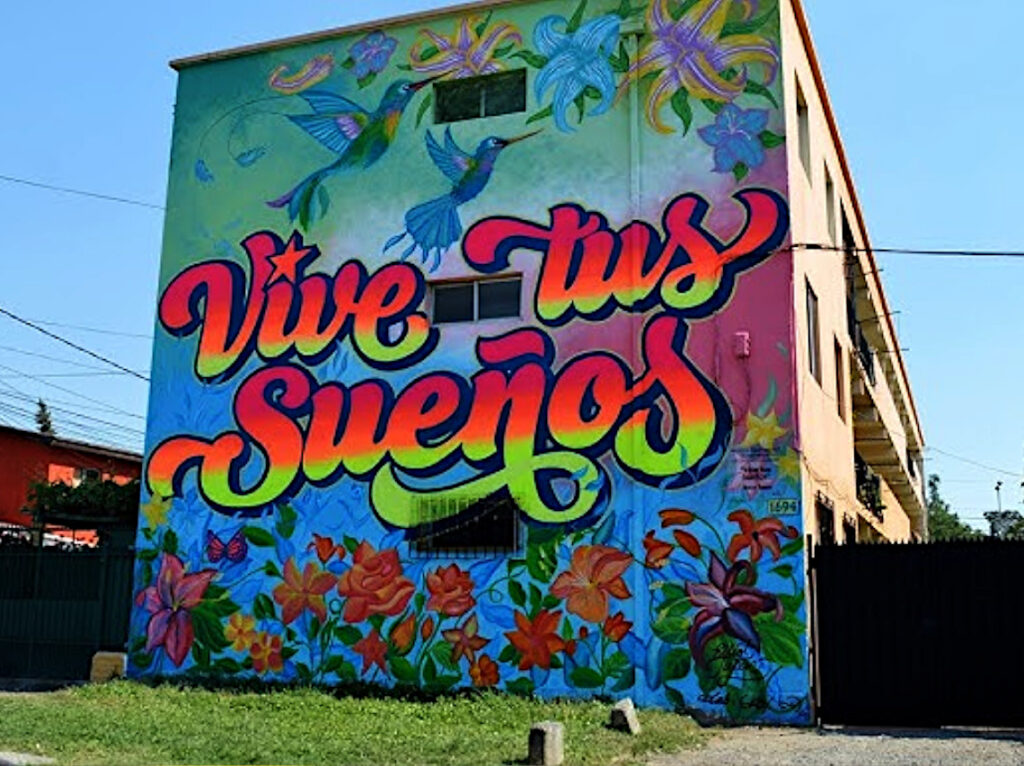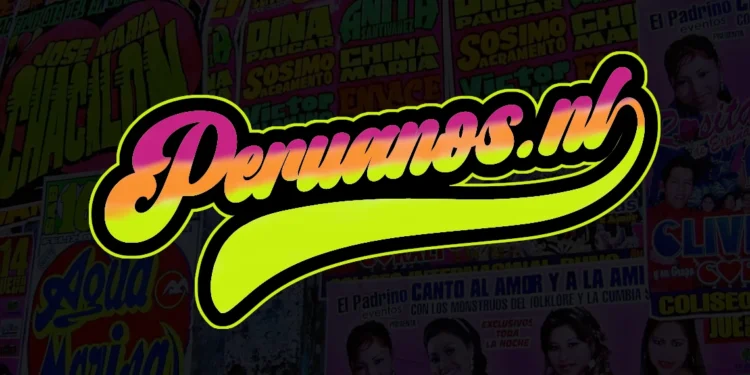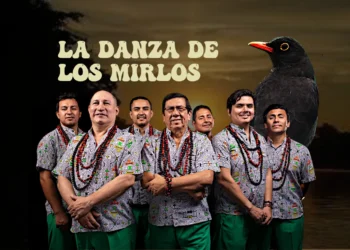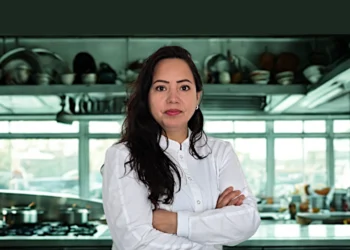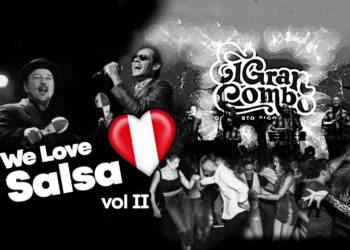This post is also available in:
Español
English
Chicha-kunst is een visuele explosie van levendige kleuren die de culturele rijkdom van een natie weergeeft. Het is een stijl die niet alleen een esthetiek definieerde, maar ook een nieuwe identiteit in Peru tot leven bracht. Ontstaan in de jaren 80, werd deze kunst, vaak omschreven als kitscherig of overdreven, de laatste jaren herwaardeerd als een manifestatie van de eigentijdse Peruaanse barok.
De Oorsprong van Chicha-kunst: Het Verhaal van Monky en de Kleuren van de Huanca Natie
Chicha-kunst heeft een unieke oorsprong. De maker, Pedro Tolomeo Rojas Meza, beter bekend als Monky, werd geboren in San Lorenzo, een district van Jauja in de regio Junín. Monky revolutioneerde het ontwerp van affiches in Peru. Eind jaren 70 verhuisde Monky van zijn geboortestad naar Lima met de droom om autotechniek te studeren, maar de omstandigheden zaten hem niet mee.
De economische situatie dwong hem te werken in een zeefdrukatelier in de wijk La Victoria in Lima, waar hij zijn artistieke talenten de vrije loop kon laten, aangezien hij al van jongs af aan graag landschappen en letters tekende. In zijn geboortedorp had hij al posters gemaakt voor enkele restaurants en winkels.
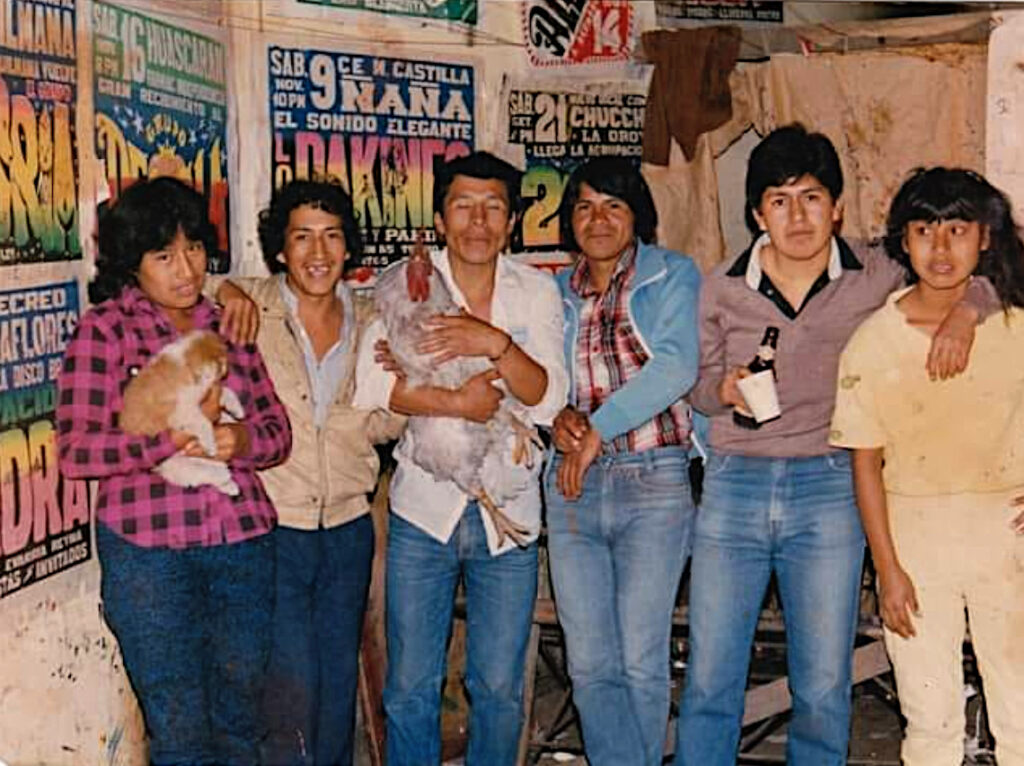
In die tijd werden posters en reclameborden in Lima gedrukt in neutrale, sobere kleuren zoals zwart-wit. Sommige gedurfde affiches gebruikten ander gekleurd papier om op te vallen. Maar dit veranderde radicaal door de komst van een visionair: Pedro Tolomeo Rojas Meza, bekend als Monky. Op een dag vroeg iemand hem een spandoek te maken voor een evenement: “Waarom maken we niet ook een poster in zeefdrukstijl?” vroeg iemand. “En daar begon het, en toen werden we populair met de affiches,” vertelt Monky.
Zijn inspiratie om fluorescerende kleuren te gebruiken kwam van de levendige kleuren in de traditionele kostuums van Andesdansen zoals de Chonguinada en Huaylas, dansen uit zijn geboortestad Huancayo. De Huanca-natie staat bekend om haar levendige en kleurrijke feesten, en Monky besloot deze vibrante kleurenpalet in zijn werk te verwerken.
Monky beschrijft zijn artistieke inspiratie vol trots: “Daar begon dat kleurspektakel, eigenlijk bracht ik die kleuren over in mijn werk, in mijn affiches… die opvallende kleuren… ik dacht: ‘waarom niet op posters?’ … nu, dankzij mijn nieuwsgierigheid, mijn speelsheid, brengen deze kleuren vreugde aan Peru, aan Lima, het grijze Lima, zoals ze zeggen.”
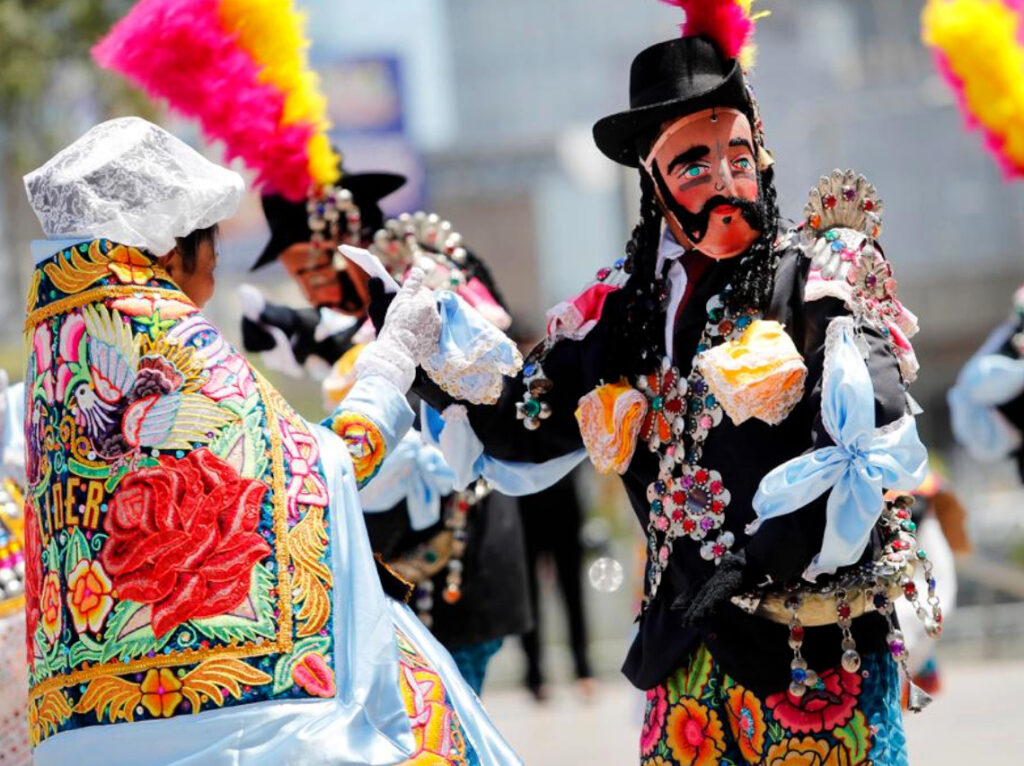
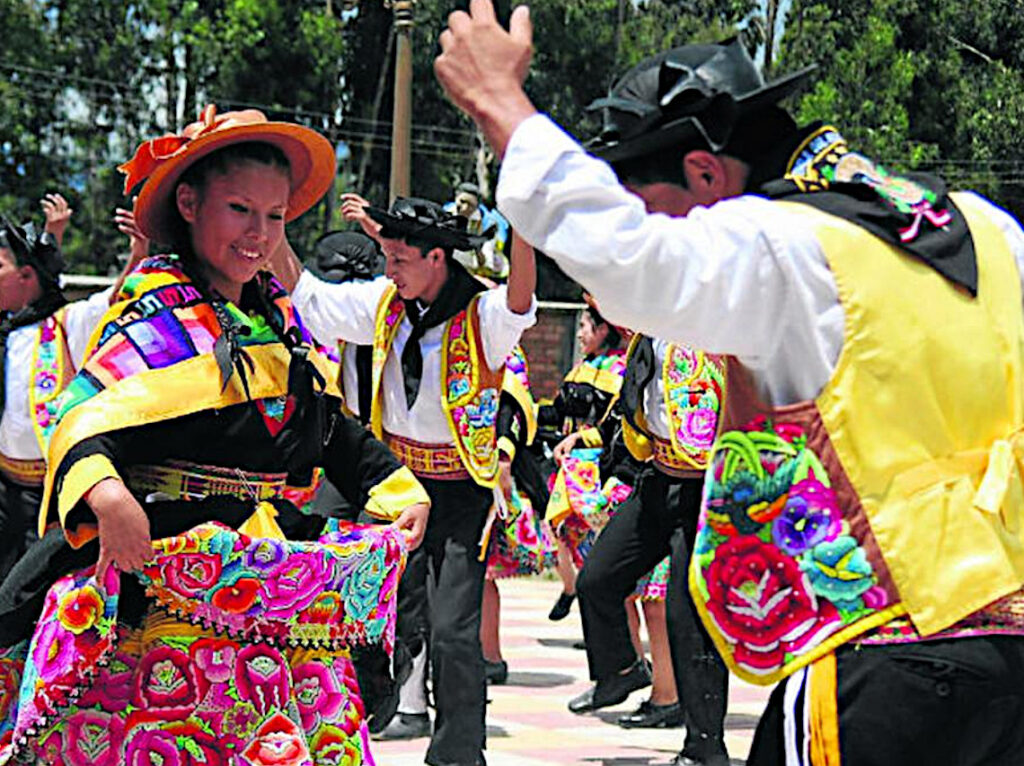
Deze speelsheid van Monky transformeerde het visuele landschap van Lima en andere steden in Peru, waarbij de straten verlicht werden met levendige affiches die de energie van de populaire muziek en cultuur vastlegden.
Chicha-muziek: De Stedelijke Hartslag van een Migrantengeneratie
Chicha-kunst is nauw verbonden met het gelijknamige muziekgenre, dat in de jaren 60 ontstond. Chicha-muziek is een fusie van Andesritmes, Colombiaanse cumbia, rock, Amazone- en Afro-Cubaanse klanken. In het begin werd het woord “chicha” denigrerend gebruikt voor migranten uit het binnenland die naar Lima kwamen en deze nieuwe muziekstijl creëerden, wat door de meer conservatieve groepen als “inferieur” werd beschouwd.
De kleurrijke, in het oog springende stijl van chicha-kunst werd al snel geassocieerd met de muziek. Los Shapis, een van de eerste chicha-bands, waren pioniers in het gebruik van kleurrijke posters die perfect pasten bij hun felle outfits, geïnspireerd door hun geboortestad Huancayo. Andere bands zoals Chacalón, Vico y su Grupo Karicia, El Grupo Guinda, Grupo Alegría en Centeno volgden dit voorbeeld, waardoor chicha-posters essentieel werden in de muziekpromotie.
Op deze manier werden chicha-muziek en chicha-kunst onafscheidelijke bondgenoten in het uiten van de opkomende cultuur van migranten die hun plek zochten in de hoofdstad.
Wat begon als een manier om concerten van chicha-bands te promoten, groeide al snel uit tot een culturele beweging met een eigen visuele identiteit. De neonkleuren en psychedelische typografie die chicha-kunst kenmerken, werden niet alleen in de muziek gebruikt, maar bij allerlei evenementen. Van Dina Páucar tot underground rockbands, allemaal adopteerden ze de chicha-stijl en creëerden een unieke esthetiek die het stedelijke Peru van het late twintigste eeuw definieerde.
Chicha-kunst: Van Verachting tot Herwaardering
Aanvankelijk werd chicha-kunst veracht door de elite van Lima, die het als kitscherig of smakeloos beschouwde. Maar tegen het einde van de jaren 2010 begonnen de nieuwe generaties, kinderen van migranten die nu de middenklasse vormen, het chicha en cholo erfgoed zowel muzikaal als artistiek te waarderen.
Grafisch kunstenaars zoals Elliot Tupac en Yefferson Huamán, evenals collectieven zoals Familia Gutiérrez, Amapolay, Unidos por un Sueño en Nación Chicha, hebben chicha-kunst naar nieuwe hoogten gebracht. Tegenwoordig zijn de chicha-posterateliers in Lima en andere steden in Peru toegenomen als antwoord op de groeiende vraag.
Tegenwoordig worden chicha-posters gebruikt om zaken zoals de bescherming van het Peruaanse regenwoud, LGBT-rechten en de strijd tegen feminicide te steunen. Zelfs in landen met Peruaanse immigranten, zoals Chili en Argentinië, zijn chicha-posters symbolen van strijd en cultureel trots geworden.
Unieke Kenmerken en Techniek van Chicha-kunst
Chicha-kunst, ambachtelijk gemaakt met de zeefdruktechniek, onderscheidt zich door het gebruik van fluorescerende, contrasterende kleurpaletten, met name in roze, groen, oranje en geel, die opvallen tegen zwarte achtergronden. Deze combinatie is perfect om aandacht te trekken in de chaotische, slecht verlichte straten van de volkswijken in Lima. De golvende typografie, beïnvloed door de psychedelica van de jaren 60 maar aangepast aan de stedelijke Peruaanse context, is ook een kenmerk, met dikke, levendige letters die lijken mee te bewegen op het ritme van chicha-muziek.
De chicha-letterstijl combineert een poëtische toets met populaire Peruaanse uitdrukkingen en jargon, waardoor directe en toegankelijke boodschappen worden gecreëerd die elk affiche niet alleen een advertentie, maar ook een culturele verklaring maken. Chicha-posters, met minimale middelen, springen eruit in de stedelijke ruimte en worden iconen van de populaire cultuur.
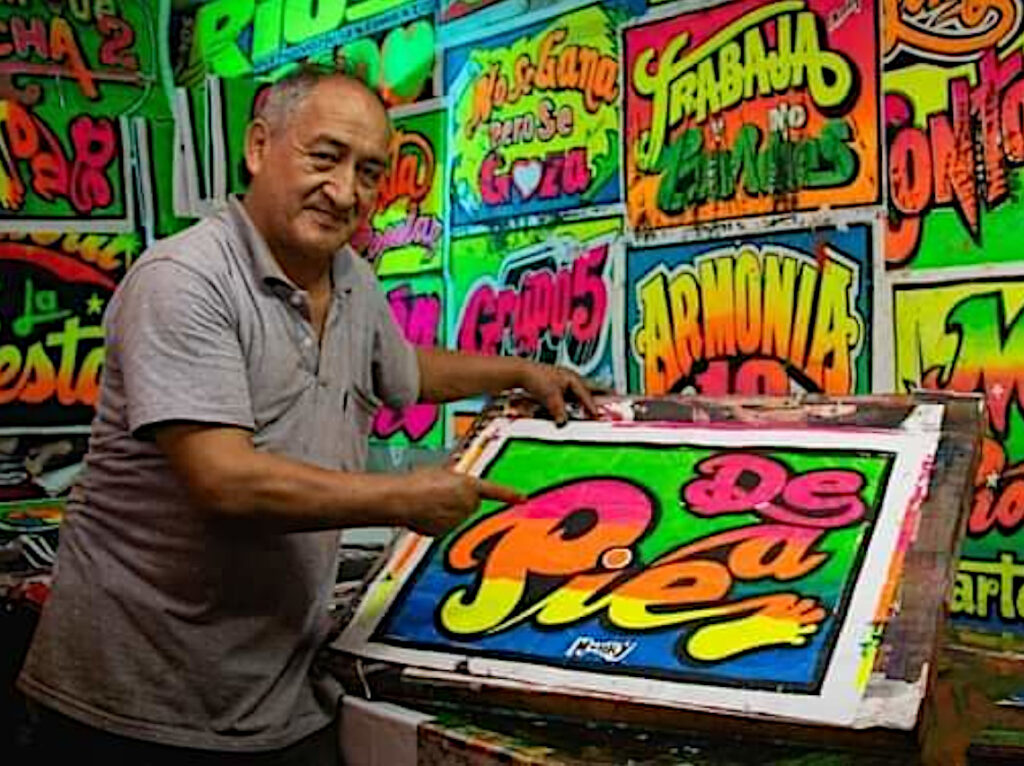
Van de Straten tot het Hart van de Peruaanse Cultuur
Vandaag de dag is chicha-kunst onderdeel van het visuele landschap van veel Peruaanse steden. Het wordt niet langer gezien als “marginaal” of “inferieur”, maar als een authentieke uiting van het stedelijke en multiculturele Peru. Van muziek tot beeldende kunst, chicha is de grenzen overgestoken en heeft galerijen en musea bereikt, en is zo een symbool geworden van de mestizo-identiteit en de volkscreativiteit van het land.
De nalatenschap van artiesten zoals Monky en bands zoals Los Shapis leeft voort in het werk van nieuwe generaties kunstenaars en grafisch ontwerpers die de chicha-stijl omarmen en herinterpreteren, niet alleen als een kunstvorm, maar ook als een uiting van culturele trots.
Chicha-kunst herinnert ons eraan dat, te midden van de stedelijke chaos en sociale spanningen, er altijd ruimte is voor creativiteit en verzet, waardoor wat ooit marginaal was het hart wordt van een gedeelde identiteit die blijft resoneren in Peru en daarbuiten.
